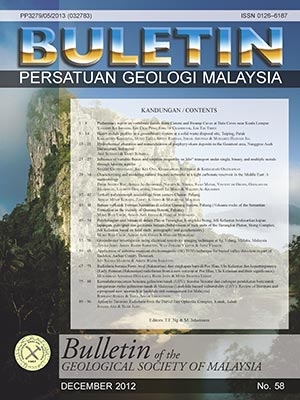
/* Style Definitions */table.MsoNormalTable{mso-style-name:"Table Normal";mso-tstyle-rowband-size:0;mso-tstyle-colband-size:0;mso-style-noshow:yes;mso-style-priority:99;mso-style-parent:"";mso-padding-alt:0cm 5.4pt 0cm 5.4pt;mso-para-margin:0cm;mso-para-margin-bottom:.0001pt;mso-pagination:widow-orphan;font-size:10.0pt;font-family:"Calibri","sans-serif";}
Bulletin of the Geological Society of Malaysia, Volume 58, December 2012, pp. 29 – 35
1 Kuwait Oil Company, P.O Box 9758, Ahmadi, 61008 Kuwait
2 Beicip-Franlab, 232 Avenue Napoleon Bonaparte, 92502 Rueil Malmaison, France
Abstract: Fractured reservoirs are challenging to handle because of their high level of heterogeneity. In particular, natural fractures have a significant impact on well performance and water production. Therefore, understanding their significance through fracture characterization is helpful in well placement and field development.
This paper presents a best practice methodology for building a 3D stochastic fracture model using a Middle Eastern tight carbonate field example. This model is generated through the analysis and integration of data including cores, borehole images (BHI), logs, mud losses, production logs, well test data and 3D seismic data.
The impact of lithology on fracture occurrence was quantified based on rock-typing. Rock-types are distributed in a 3D geological model using a high resolution sequence stratigraphic framework. The length, dip angle and orientation of fractures, together with the shale content of the facies where they occur, were defined to sort the tectonic fractures from the non-tectonic (diagenetic) ones. It was found that multiple sets of tectonic diffuse fractures are generally associated with cleaner limestone units. Altogether, three sets of diffuse fractures were identified from BHI data: NE-SW, EW and NW-SE. In addition, large-scale fracture corridors, including sub-seismic faults identified from seismic analysis, were detected and calibrated with cores and BHI. The final model incorporates two scales of tectonic fractures with a direct bearing on field production behavior: diffuse fractures and large fracture corridors.
Fracture calibration was performed using production logs and well production data. Permeability at wells was computed in the 3D fracture model and matched with real build-up data. These data were then used to propagate 3D fracture properties (fracture porosity, fracture permeability and equivalent block size) in the upscaled geological model, for constructing a full-field reservoir simulation model. Few changes of the fracture properties were needed to obtain a good history match, indicating that the fracture model produced is robust.
Keywords: tight carbonate, fracture, DFN model, fracture porosity, fracture permeability
https://doi.org/10.7186/bgsm58201205